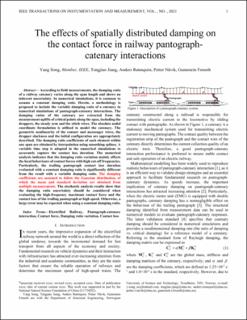| dc.contributor.author | Song, Yang | |
| dc.contributor.author | Jiang, Tengjiao | |
| dc.contributor.author | Rønnquist, Anders | |
| dc.contributor.author | Nåvik, Petter Juell | |
| dc.contributor.author | Frøseth, Gunnstein Thomas | |
| dc.date.accessioned | 2021-11-16T09:42:42Z | |
| dc.date.available | 2021-11-16T09:42:42Z | |
| dc.date.created | 2021-11-12T12:41:37Z | |
| dc.date.issued | 2021 | |
| dc.identifier.issn | 0018-9456 | |
| dc.identifier.uri | https://hdl.handle.net/11250/2829771 | |
| dc.description.abstract | According to field measurements, the damping ratio of a railway catenary varies along the span length and shows an inherent uncertainty. In numerical simulations, it is common to assume a constant damping ratio. Herein, a methodology is proposed to include the variable damping ratio of a catenary in numerical simulations of pantograph-catenary interactions. The damping ratios of the catenary are extracted from the measurement uplifts of critical points along the span, including the droppers, the steady arm, and the stitch wires. The absolute nodal coordinate formulation (ANCF) is utilized to model the catenary. The geometric nonlinearity of the contact and messenger wires, the dropper slackness and the initial configuration are appropriately described. The damping ratio coefficients of each element within one span are obtained by interpolation using smoothing splines. A variable time step is adopted in the numerical simulations to accurately capture the contact loss duration. The numerical analysis indicates that the damping ratio variation mainly affects the local behaviors of contact forces with high cutoff frequencies. Particularly, the trailing pantograph contact loss duration evaluated with a constant damping ratio is significantly different from the result with a variable damping ratio. The damping coefficients are assumed to follow the Gaussian distribution, of which the mean and standard deviation are obtained from multiple measurements. The stochastic analysis results show that the damping ratio uncertainty should be considered when evaluating the high-frequency maximum contact force and the contact loss of the trailing pantograph at high speed. Otherwise, a large error may be expected when using a constant damping ratio. | en_US |
| dc.language.iso | eng | en_US |
| dc.publisher | Institute of Electrical and Electronics Engineers (IEEE) | en_US |
| dc.title | The Effects of Spatially Distributed Damping on the Contact Force in Railway Pantograph-Catenary Interactions | en_US |
| dc.type | Peer reviewed | en_US |
| dc.type | Journal article | en_US |
| dc.description.version | acceptedVersion | en_US |
| dc.rights.holder | © IEEE. Personal use of this material is permitted. Permission from IEEE must be obtained for all other uses, in any current or future media, including reprinting/republishing this material for advertising or promotional purposes, creating new collective works, for resale or redistribution to servers or lists, or reuse of any copyrighted component of this work in other works. | en_US |
| dc.source.journal | IEEE Transactions on Instrumentation and Measurement | en_US |
| dc.identifier.doi | 10.1109/TIM.2021.3091459 | |
| dc.identifier.cristin | 1954079 | |
| cristin.ispublished | true | |
| cristin.fulltext | postprint | |
| cristin.qualitycode | 1 | |
